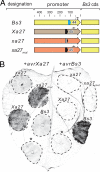A single plant resistance gene promoter engineered to recognize multiple TAL effectors from disparate pathogens
- PMID: 19910532
- PMCID: PMC2776607
- DOI: 10.1073/pnas.0908812106
A single plant resistance gene promoter engineered to recognize multiple TAL effectors from disparate pathogens
Abstract
Plant pathogenic bacteria of the genus Xanthomonas inject transcription-activator like (TAL) effector proteins that manipulate the hosts' transcriptome to promote disease. However, in some cases plants take advantage of this mechanism to trigger defense responses. For example, transcription of the pepper Bs3 and rice Xa27 resistance (R) genes are specifically activated by the respective TAL effectors AvrBs3 from Xanthomonas campestris pv. vesicatoria (Xcv), and AvrXa27 from X. oryzae pv. oryzae (Xoo). Recognition of AvrBs3 was shown to be mediated by interaction with the corresponding UPT (UPregulated by TAL effectors) box UPT(AvrBs3) present in the promoter R gene Bs3 from the dicot pepper. In contrast, it was not known how the Xoo TAL effector AvrXa27 transcriptionally activates the matching R gene Xa27 from the monocot rice. Here we identified a 16-bp UPT(AvrXa27) box present in the rice Xa27 promoter that when transferred into the Bs3 promoter confers AvrXa27-dependent inducibility. We demonstrate that polymorphisms between the UPT(AvrXa27) box of the AvrXa27-inducible Xa27 promoter and the corresponding region of the noninducible xa27 promoter account for their distinct inducibility and affinity, with respect to AvrXa27. Moreover, we demonstrate that three functionally distinct UPT boxes targeted by separate TAL effectors retain their function and specificity when combined into one promoter. Given that many economically important xanthomonads deliver multiple TAL effectors, the engineering of R genes capable of recognizing multiple TAL effectors provides a potential approach for engineering broad spectrum and durable disease resistance.
Conflict of interest statement
The authors declare no conflict of interest.
Figures




Similar articles
-
Transcription activator-like type III effector AvrXa27 depends on OsTFIIAgamma5 for the activation of Xa27 transcription in rice that triggers disease resistance to Xanthomonas oryzae pv. oryzae.Mol Plant Pathol. 2009 Nov;10(6):829-35. doi: 10.1111/j.1364-3703.2009.00567.x. Mol Plant Pathol. 2009. PMID: 19849788 Free PMC article.
-
Designer TAL effectors induce disease susceptibility and resistance to Xanthomonas oryzae pv. oryzae in rice.Mol Plant. 2013 May;6(3):781-9. doi: 10.1093/mp/sst034. Epub 2013 Feb 21. Mol Plant. 2013. PMID: 23430045
-
Addition of transcription activator-like effector binding sites to a pathogen strain-specific rice bacterial blight resistance gene makes it effective against additional strains and against bacterial leaf streak.New Phytol. 2012 Sep;195(4):883-893. doi: 10.1111/j.1469-8137.2012.04216.x. Epub 2012 Jul 2. New Phytol. 2012. PMID: 22747776
-
Xanthomonas AvrBs3 family-type III effectors: discovery and function.Annu Rev Phytopathol. 2010;48:419-36. doi: 10.1146/annurev-phyto-080508-081936. Annu Rev Phytopathol. 2010. PMID: 19400638 Review.
-
[Molecular recognition code between pathogenic bacterial TAL-effectors and host target genes: a review].Sheng Wu Gong Cheng Xue Bao. 2011 Aug;27(8):1132-41. Sheng Wu Gong Cheng Xue Bao. 2011. PMID: 22097801 Review. Chinese.
Cited by
-
A single promoter-TALE system for tissue-specific and tuneable expression of multiple genes in rice.Plant Biotechnol J. 2022 Sep;20(9):1786-1806. doi: 10.1111/pbi.13864. Epub 2022 Jun 24. Plant Biotechnol J. 2022. PMID: 35639605 Free PMC article.
-
The Tug-of-War between Plants and Viruses: Great Progress and Many Remaining Questions.Viruses. 2019 Feb 28;11(3):203. doi: 10.3390/v11030203. Viruses. 2019. PMID: 30823402 Free PMC article. Review.
-
A Transcription Activator-Like Effector Tal7 of Xanthomonas oryzae pv. oryzicola Activates Rice Gene Os09g29100 to Suppress Rice Immunity.Sci Rep. 2017 Jul 11;7(1):5089. doi: 10.1038/s41598-017-04800-8. Sci Rep. 2017. PMID: 28698641 Free PMC article.
-
Genome-wide Association Analysis Tracks Bacterial Leaf Blight Resistance Loci In Rice Diverse Germplasm.Rice (N Y). 2017 Dec;10(1):8. doi: 10.1186/s12284-017-0147-4. Epub 2017 Mar 21. Rice (N Y). 2017. PMID: 28321828 Free PMC article.
-
The Xa7 resistance gene guards the rice susceptibility gene SWEET14 against exploitation by the bacterial blight pathogen.Plant Commun. 2021 Jan 19;2(3):100164. doi: 10.1016/j.xplc.2021.100164. eCollection 2021 May 10. Plant Commun. 2021. PMID: 34027391 Free PMC article.
References
-
- Jones JD, Dangl JL. The plant immune system. Nature. 2006;444:323–329. - PubMed
-
- Anderson PK, et al. Emerging infectious diseases of plants: Pathogen pollution, climate change, and agrotechnology drivers. Trends Ecol Evol. 2004;19:535–544. - PubMed
-
- Michelmore R. The impact zone: Genomics and breeding for durable disease resistance. Curr Opin Plant Biol. 2003;6:397–404. - PubMed
-
- Hogenhout SA, Van der Hoorn RAL, Terauchi R, Kamoun S. Emerging concepts in effector biology of plant-associated organisms. Mol Plant-Microbe Interact. 2009;22:115–122. - PubMed
-
- Oliver R. Plant breeding for disease resistance in the age of effectors. Phytoparasitica. 2009;37:1–5.
Publication types
MeSH terms
Substances
LinkOut - more resources
Full Text Sources
Other Literature Sources
Miscellaneous

